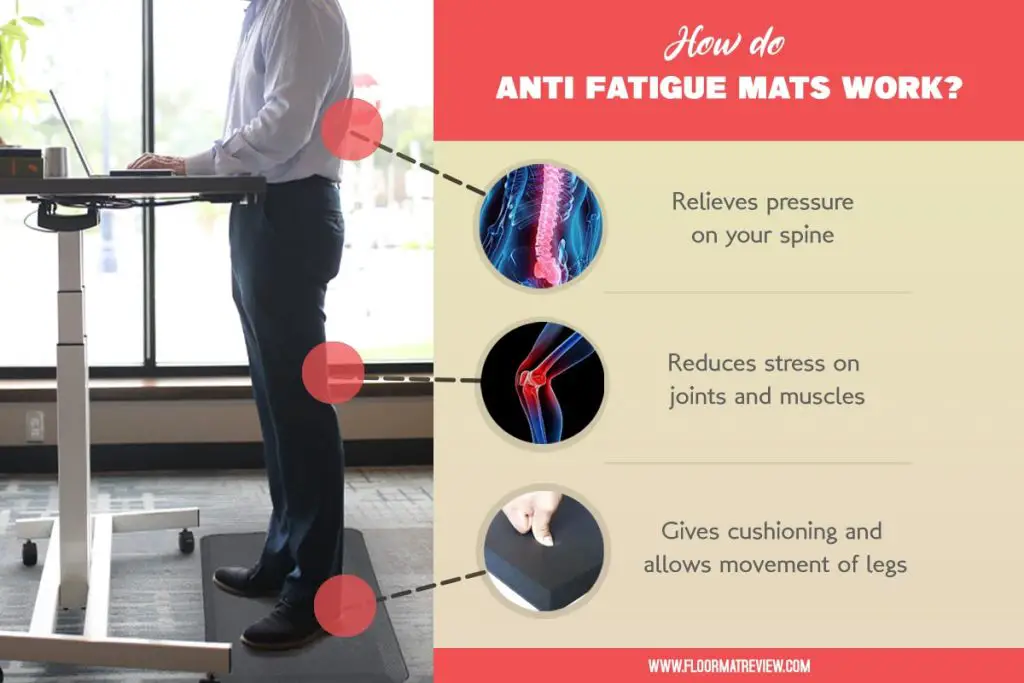How Do Anti Fatigue Mats Work? How to Choose an Anti Fatigue Mat?
Anti-Fatigue Mats are specially designed mats to reduce fatigue caused by standing on hard surfaces for long periods. They are of different materials like rubber, vinyl, carpeting materials, wood, etc.
How does Fatigue Occur?
When we take a step, our calf muscles contract and squeeze blood back up to our heart. The veins even control the direction of the blood flow. This continuous process works only when our leg muscles are relaxing and contracting like when we walk, run or participate in other activities.
However, when a person has to stand still on a hard and flat surface like a cement floor, for prolonged periods this process comes to a halt as the legs do not need to move much to keep one erect.
As result blood pools in the lower limbs and the heart has to pump it back around the body by itself causing us to feel fatigued. It is this blood pooling in the legs and the increased pressure on the joints that can result in severe pain in the lower back, knees, legs, and neck.
Our bodies are designed in such a manner that because of the gravitational effect when we are standing upright, we should be moving rather than standing still. As when we are stationary our muscles need to tense so that we can maintain our balance. This causes greater fatigue too.
A study conducted by Longborough University concluded that standing still continuously for just ninety minutes can cause serious discomfort to the feet, legs, and back as well as stiffness to the neck and shoulders
How Do Anti Fatigue Mats Work?

Anti-fatigue mats help to alleviate stress and reduce fatigue by providing a softer surface to stand on. Generally, soft and flexible materials like rubber or memory foam are used to manufacture anti-fatigue mats.
This flexibility stimulates the subtle movement of the calf muscles and prevents one from being completely motionless. One has to constantly adjust his feet to maintain the balance of his body.
The pressure of standing up is evenly distributed across both legs such that one leg does not have to support more weight than the other.
This results in an improved posture and reduction of stress on the joints. Periodic changes in posture diminish tension in the shoulders and neck, relieve headaches, and take the pressure off the backbone.
Thus it helps in increasing the productivity of men at work. Using anti-fatigue mats helps in reducing circulatory problems. Anti-fatigue mats also act as cushions as they absorb shocks and vibrations making them more comfortable for one’s feet.
The discomfort from too much standing on ceramic or concrete floors can cause swelling in the legs, varicose veins, cardiovascular problems, stiffness in the neck and shoulder. Office workers regularly complain about lower back pain which is a common musculoskeletal disorder.
Scientific research suggests that workers who use these mats report notable improvement in these problems. We have all heard of accidents at work due to slips, trips, or falls.
Mostly anti-fatigue mats have a ribbed surface and are non-slip in nature. They significantly reduce slips trips and falls as they grip the floor.
What Does an Anti Fatigue Mat Do?
Anti-fatigue mats come in diverse shapes, sizes, and colors to suit different requirements. Their thickness and elasticity can vary too depending upon the material used.
As such, buying these ergonomic mats is a reasonable investment for long-term benefits. Professional chefs or home-based caterers often have to stand at kitchen counters for hours.
Anti-fatigue mats help to reduce their stress. Cashiers at supermarkets or professors who stand at the podium benefit from using these mats.
Auto mechanics or serious hobbyists like painters or craftsmen use them regularly. Average office workers who need to stand at their workstations report significantly lesser fatigue since using these mats.
How Do I Choose an Anti Fatigue Mat?
1. Pressure
Anti-fatigue mats offer a weight range to choose from. One should choose a mat depending upon the pressure it can withstand. A mat meant for 150 pounds will lose its anti-fatigue properties in due course of time if a person weighing 250 pounds regularly uses it.
2. Resilience
A good quality anti-fatigue mat should return to its original shape consistently as one moves around on it. Thus, a highly soft mat will not last long compared to an orthopedic one.
On the other hand, a very hard mat if used over a concrete floor surface will cause unwanted pressure and discomfort o the legs thus defeating the purpose altogether.
3. Sanitary Aspects
Anti-fatigue mats in kitchens often collect food bacteria and those are inside bathrooms are a haven for germs. So one should always buy mats that are washable or at least sanitized regularly.
Also, it should be super resistant to stains, water, punctures and be easy to clean. Most high-quality anti-fatigue mats are easy to clean with basic cleaners.
4. Safety Issues
Most anti-fatigue mats have beveled edges to allow smooth movements from mat to floor and avoid slipping or tripping hazards. For smaller mats, one should use double-sided rug tape to fix it securely in place.
For slippery surfaces, one should choose mats with textured surfaces that offer additional traction by minimizing slips and falls. The best mats have a tapered edge to prevent slipping and the wider the taper the better it is.
5. Thickness
The thickness of a mat is also an important aspect. The best anti-fatigue mats are minimum 3/8 inch, ½ inch, or about 1-inch thick.
One shouldn’t buy a mat that is too thick, as that will not provide adequate support to the body. Similarly, choosing a very thin mat will lead to aches and pains in the legs.
6. Durability
High-density foam covered with strong material makes the best anti-fatigue mats. These mats are designed specifically to distribute body weight evenly. The correct anti-fatigue mat should be strong enough to withstand regular wear and tear.

